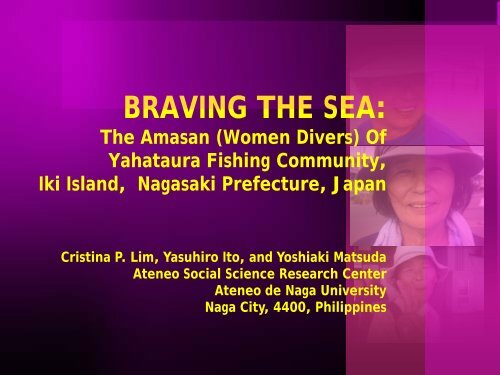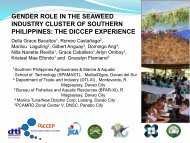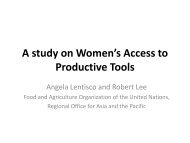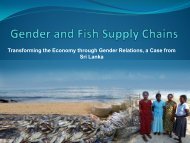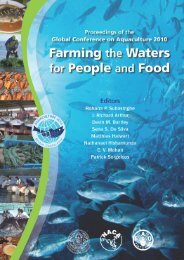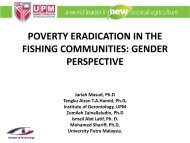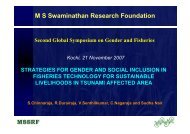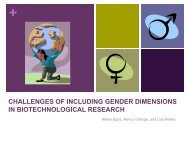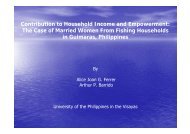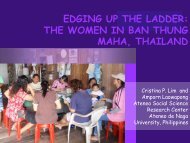Cristina P. Lim - GENDER IN AQUACULTURE AND FISHERIES
Cristina P. Lim - GENDER IN AQUACULTURE AND FISHERIES
Cristina P. Lim - GENDER IN AQUACULTURE AND FISHERIES
You also want an ePaper? Increase the reach of your titles
YUMPU automatically turns print PDFs into web optimized ePapers that Google loves.
BRAV<strong>IN</strong>G THE SEA:<br />
The Amasan (Women Divers) Of<br />
Yahataura Fishing Community,<br />
Iki Island, Nagasaki Prefecture, Japan<br />
<strong>Cristina</strong> P. <strong>Lim</strong>, Yasuhiro Ito, and Yoshiaki Matsuda<br />
Ateneo Social Science Research Center<br />
Ateneo de Naga University<br />
Naga City, 4400, Philippines
Objectives<br />
Methodology<br />
Findings<br />
Conclusions<br />
Recommendations<br />
Outline of Presentation
Objectives<br />
To know and understand the situation of women in the<br />
coastal village of Yahataura, Iki, Island, Nagasaki<br />
Prefecture, Japan.<br />
Specifically, it looks into the:<br />
men and women’s access to and control over<br />
resources;<br />
activities and the time allocation;<br />
women’s views about their work; and<br />
their longings in life.
Participatory Rapid Appraisal<br />
Gender Resource Map<br />
Social Map<br />
Calendar of Activities<br />
24-hour clock<br />
Participant Observation<br />
Key Informant Interview<br />
Photo Documentation<br />
Methodology
Study Site<br />
Iki Island
What is an Ama? Who are they?<br />
Literally - “sea person”<br />
Professional men and women divers who use high<br />
speed diving technique but without air tanks.<br />
Diving prowess depends largely on the lung<br />
capacity, diving speed, resistance to cold, intuition<br />
for finding their catch and determination to<br />
succeed.
Mobile - moving from west to east along the Japanese<br />
coastline. And as the men Ama found other jobs in fishing,<br />
women divers were left to do most of the diving. Over the<br />
years, the word, Ama, was associated to women divers.<br />
Women divers dive for<br />
abalone, turban shells<br />
and sea urchin
Number of Ama in Yahataura<br />
54 Female Ama<br />
24 (50s)<br />
17 (60s)<br />
5 (40s)<br />
4 (70s)<br />
3 (30s)<br />
1 (20s)<br />
Projection: decline in number
Types of Ama<br />
The Funado Ama<br />
Younger Ama<br />
use colorful tubs (orange, yellow, pink)<br />
dived in groups, usually 5-6 members, and<br />
assisted by a boat operator.<br />
Dive from an anchored boat to a much deeper<br />
fishing ground (7-15 meters)<br />
Diving lasts for 30-40 seconds, 30 seconds of<br />
rest before the next dive.
Types of Ama<br />
The cachido (walking people) Ama<br />
Older Ama, the oldest being 74 years old<br />
reliant on the services of the boat men who would<br />
take them to the breakwater and back to the<br />
fishing port<br />
dived to a depth of 4-6 meters to collect seashells.<br />
Diving lasts for 30 seconds then 30 seconds of<br />
rest
Ama’s Diving Wear
Ama’s Diving Wear
Ama’s Diving Tools<br />
Hanzo - a metal made color coded<br />
bucket float used as a container for<br />
their catch at the same time a<br />
locator of the Amasan’s whereabout<br />
Awabi Okashi - one being short and<br />
small for easier picks while the<br />
longer one is for deep crevices and<br />
crannies<br />
Awabi ami - a net bag for placement<br />
of abalone catch
Ama’s Diving Tools<br />
Uni-tori, a handheld instrument<br />
with a hooked tip for picking of<br />
sea urchin<br />
Pumpo, an elongated plastic pump<br />
used to pump the water out of the<br />
bucket to prevent it from sinking<br />
Uki, a floater<br />
Omori, an anchor, which is tied to a<br />
rope
Ama’s Social<br />
Center<br />
(Amagoya)
Ama’s Diving Time<br />
2 Diving trips a day:<br />
11:00 AM until 1 PM, when plentiful or<br />
2 PM, when scarce<br />
2:20 or 3 PM until 5:00 PM
Ama’s Diving Practice<br />
Application of a heavy foundation cream to protect<br />
the face from the salt and scorching heat of the sun<br />
and thus, maintain an unblemish facial skin.
Ama’s Diving Practice<br />
Preparation of the gum which they would<br />
insert in their ears to safeguard them from<br />
the sea water and pressure.<br />
Intake of some vitamins and medicines for<br />
cold.<br />
Washing of goggles with a Ramin leaf and<br />
sea water before putting them on.
Ama’s Diving Practice<br />
Putting on of modern flippers<br />
Taking on the bucket with their gears inside it and<br />
swimming out to their chosen spot in the sea.
Ama’s Whistle Sound (Isoboue)<br />
Ama’s whistle sound resembled that of a “deep sigh<br />
or gasp” which is either short or long.<br />
a short “ha” or a long “haay” - very disturbing as it<br />
tries to communicate a laborious pain.<br />
Done when gasping for some air and re-adjusting<br />
their breathing.<br />
When at sea, one could not miss the Ama because of<br />
their whistle, beside their floating colorful tubs.
Annual Income (in 000 Yen)<br />
Ama’s Income<br />
70<br />
60<br />
50<br />
40<br />
30<br />
20<br />
10<br />
0<br />
2004 2009 2014 2019<br />
Year<br />
Income Number<br />
Trend in annual income and number of<br />
Amasan, Tobu FCA, 2004-2019.<br />
60<br />
50<br />
40<br />
30<br />
20<br />
10<br />
0<br />
Number pf Amasan<br />
In 2007, the average<br />
per capita annual<br />
income of Amasan<br />
reached 61,086,603<br />
yen. By age, the<br />
highest average<br />
annual income,<br />
1,522,232 yen, was<br />
earned by those in<br />
the age bracket 50-59<br />
years.
Ama’s Access to and Control Over Resources<br />
.<br />
• Ownership of farm lots and the<br />
responsibility of managing them<br />
generally fall on men.<br />
• The fishery rights are given to the<br />
which distributed to its members<br />
who are dominated by men. In<br />
general, the right to harvest fish<br />
species with the use of fixed gears,<br />
beach seines, and the likes or the<br />
culture of fish or pearl is delegated<br />
to men<br />
• Some women whose husbands<br />
owned parcel of lot, engaged in<br />
farming to support their husband.<br />
• The fishery right for seaweeds<br />
and sedentary fishery (abalone,<br />
turban shells or sasae, and sea<br />
urchin) is largely assigned to<br />
women.
Ama’s Access to Administrative Decision Making<br />
Position<br />
Board of Directors (5)<br />
13 core staff, 7<br />
females -clerical<br />
Committee Committee Committee Committee<br />
Tobu FCA, Yahataura
Ama’s (vs husband) Calendar of Activities<br />
Activities Jan Feb Mar Apr May Jun Jul Aug Sep Oct Nov Dec<br />
Household<br />
chores<br />
Mobile<br />
Fish<br />
Sedentary<br />
Fish
Community Activities<br />
AMA Cooperative Gen Assembly<br />
AMA meeting<br />
AMA and Boatmen meeting<br />
Yahataura AMA and other AMA in Iki<br />
Fish stocking (sea urchin, abalone, scorpions)<br />
Cleaning of seashore<br />
Special religious ceremony
Food preparation<br />
Community Activities<br />
Help in stocking of fish,<br />
cleaning and reforesting<br />
the sea<br />
Offering of food to the<br />
gods<br />
Cleaning of the venue<br />
Take the lead in stocking of<br />
fish in and cleaning and<br />
reforesting the sea
How Ama viewed their works<br />
A welcome relief as it becomes a source of<br />
additional income.<br />
Economically empowering providing them an<br />
avenue for making decisions.<br />
Opportunity to be in union with nature<br />
A dangerous job<br />
Venue for socialization<br />
An exercise
Problems and Aspirations<br />
Deteriorating health Good health<br />
Polluted water Increase Catch<br />
Declining catch More trained Ama<br />
Children finish<br />
schooling
Conclusion<br />
Ama plays a crucial role in Japanese fisheries.<br />
While the Japanese constitution forbids<br />
discrimination on the basis of sex, and Japanese<br />
law affords women the same economic and social<br />
rights as men, the reality of Japanese women<br />
having a low social status still pervades the<br />
society.<br />
The dominance of male in the managerial<br />
positions in the organizational structure of the<br />
cooperative reflects marginalization of women.
Gender division of labor characterized by rigid<br />
delineation of the productive and reproductive<br />
spheres also reflective of strong sense of<br />
patriarchy<br />
Women Ama were more than homemakers.<br />
They, too, were breadwinners just like their<br />
husbands<br />
As elsewhere, Women Ama performed multiple<br />
task, a task which when they wake up in the<br />
morning they will do it all again.
What can be done?<br />
Issues of cultural and social superiority have to be<br />
addressed to redress gender inequality.<br />
Need for the community to embrace a respect for<br />
women Ama and promote policies that increase the<br />
personal wealth, power and political influence of<br />
women Ama.<br />
A survey of women Ama in Japan<br />
A quantitative study on Japanese men and women<br />
in fisheries giving particular to their activities, time<br />
allocation and income
More empirical studies on women in the fisheries<br />
for greater exposure and hopefully, stir attention<br />
and discussion from the public.<br />
More opportunities for women participation in the<br />
decision-making of the cooperatives, relegation of<br />
women to position of leadership, and men’s<br />
participation in domestic chores.<br />
Need for educational reforms to alter traditional<br />
notions (public information campaigns or school<br />
textbooks)
THANK YOU!


